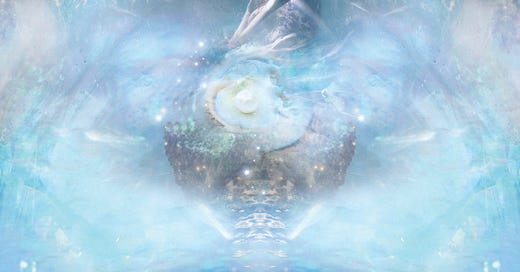Christmas and The Pregnant Virgin
Christmas feels like another Black Friday. But there's deep symbolism to be found in its celebration of birth.
We may not like to admit it out loud, but in our society Christmas is just another Black Friday, though dressed in red: a podlatch of excessive buys, excessive partying, excessive eating, excessive time, excessive family, excessive rest, excessive everything.
As Marion Woodman, Jungian psychologist whose words resonate deeply within me, put it in one of her conferences, “we spend our days around the holidays prepping food we do not want to eat, buying alcohol we do not want to drink, spending money we do not want to spend, to buy gifts for people we do not want to see, and all of it, while feeling a strong disconnect from ourselves, our bodies and souls.”
And yet, the festivities around Christmas are filled with meaning, with resonance, and if only we’d allow ourselves to stop and feel their message, we would experience them differently.
Christmas is a celebration of rebirth, with a strong emphasis on its cyclical, continuous, perpetual nature.
And not just in nature.
In her book The Pregnant Virgin, Marion Woodman speaks of the Pregnant Virgin as a metaphor for our innate ability—both as women and as human beings—to simultaneously embody “virgin soil,” fertile ground ready for new ideas, new ways of being, and new perspectives, and “fruitful soil,” where a new project has already been sown. And just like in the early stages of pregnancy, where a fetus is developing but its presence is invisible to the eye, this project-in-embryo may be on its way to bring something concrete, tangible, and revolutionary into the world, and yet requires a believing, a leap of faith, and an allowing for the soil to be at once virgin and fruitful.
And it all begins with desire, with a wish to bring light into the world, even as the bringing of light demands a willingness to go into the darkness. Again, these are themes that are omnipresent at Christmas, which is both the darkest time of the year (in the northern hemisphere), and that season during which we most turn to the light (hence festive balloons, and Christmas trees, and lighted candles, and so on…)
What desire? That yearning to bring out our own light, to shine like the sun, without needing to lean into pretending, hypocrisy, or masking. We all want to bring out the best of ourselves.
And according to philosopher Igor Sibaldi, that desire is like an infinite horizon, an aspiration. And, he writes, there is no stronger aspiration than that of embodying the individual who has found that which is infinite, not outside, but within themselves.
That desire to let ourselves shine, however, is both joyous and challenging.
It is challenging, because it usually first manifests as a longing for more, paired with a sense of uncertainty about where that “more” will take us.
We’ve all felt it: the desire to start a new job, accompanied by doubts about whether it will be the right place for us. The excitement of planning a trip, mixed with the familiar worry about getting sick from the local food, running out of money, getting scammed, or simply, feeling out of place. The thrill of a new relationship, tinged with fears of losing ourselves in it.
And once we finally muster the courage to board the plane and land in an unfamiliar place, we might not find the coffee we prefer, or the pancakes we so deeply love, but we might instead stumble upon a market so colorful and magical, it propels us into a new realm. Or we may start that new job and find ourselves surrounded by new colleagues who inspire and motivate us. Then again, we might join a new training center, and wake up a month later, astonished by how much the quality of our sleep has improved.
The taking of the step towards the light may be filled with tension, but the release of that tension is profoundly liberating.
Indeed, even in childbirth, there’s something called a “birthgasm,” otherwise known as an orgasm during birth, i.e. a release of tension in waves, accompanied by an energy surge that flows through the mother’s body, and mind, at the time of delivery. And even though this is a phenomenon that’s not widely spoken about, it is estimated that as many as 69% of midwives have witnessed it.
And this is the real invitation hidden behind all the lore of Christmas: that we allow ourselves to release the old, and step towards our own light, in a leap of faith we will be rewarded for.
And that’s a celebration.



